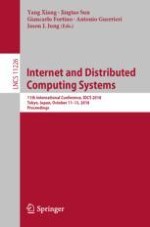This book constitutes the proceedings of the 11th International Conference on Internet and Distributed Computing Systems, IDCS 2018, held in Tokyo, Japan, in October 2018.
The 21 full papers presented together with 5 poster and 2 short papers in this volume were carefully reviewed and selected from 40 submissions. This conference desired to look for inspiration in diverse areas (e.g., infrastructure and system design, software development, big data, control theory, artificial intelligence, IoT, self-adaptation, emerging models, paradigms, applications and technologies related to Internet-based distributed systems) to develop new ways to design and mange such complex and adaptive computation resources.
